One of the many attractions that continue to lure me back to Hong Kong is that it is a city that has raised signage to a high art and lowered it to banality and kitsch. In between it is almost always good for a laugh or a groan, and oftentimes a lesson in the wayward uses of English grammar.
The sign next to the elevator button in my building read, in English and Chinese, “When there is a fire, do not use the elevator.” It gives me pause for both grammatical and more visceral reasons. “When.” Not “If there is a fire,” but “when.” There’s an uncomfortable inevitability lurking in the ambiguity. Maybe they should post the hours when fires are to be expected.

©2011, UrbisMedia-Ltd.
I must admit, Cantonese, not English, is the “native” language here, and I ought to be grateful that they’ll put even an ambiguous legible sign up for my safety. So I am, grateful, if not necessarily comfortable, as much for the entertainment of signs as their information. One receives such a bonus in a city where even toilets have gender. There is perhaps not much ambiguity about signs such as “Male Toilet” and “Female Toilet,” but “Disabled Toilet” leaves one wondering whether it is a reference to one’s eligibility to use the convenience, or to its functional condition.

©2011, UrbisMedia-Ltd.
So Hong Kong signs have become a minor study for me. Of course there is the wonderful profusion of street signs, big, garish neon calls from restaurants and shops, clamoring for the pedestrian’s and transit rider’s attention, and often creating a kaleidoscopic canopy over the narrow streets and lanes and broader commercial thoroughfares like Nathan Road. Big, bright, sometimes blinking, Chinese characters scream their mostly incomprehensible messages at me. I do understand the profusion of symbols—the shark fins, bird nests, cameras, computers, almost any product or service that can be rendered by the local master workers of neon into the international visual language of art.
But in between, like the sign of the elevator, many smaller, more amusing, and more curious signs abound in Hong Kong. At a street corner road repair site in Wanchai I spy a hand-painted yellow sign hung on one of the barriers to steer, I presume, pedestrians away from using the street to pass by. But it is right in the curb and can be read by pedestrians as well as drivers going past. It reads, in English and Chinese, “Slow Pedestrians.” OK, probably not all of them are bright, or swift, but does this sign mean that this is where they are supposed to walk, or “watch out” because they might not be able to get out of the way? I suppose it could have read “Caution Pedestrians,” but without the comma between the words, it would be as ambiguous as the “Caution Children” signs on the shuttle busses that take them to and from school. I can only presume that the Chinese characters relay a more specific message. Such minor grammatical errors and ambiguities are hardly a cause for much concern (unless one is a torts lawyer; then, of course, it’s a living).

©2011, UrbisMedia-Ltd.
Chinese can be superstitious about names and locations. The orientations of objects like furniture, buildings, numbers, colors, many things, have a metaphysical, feng shui, significance to them. Even their names convey various aspects of fortune in life. What you call someone can make a difference in how they perceive themselves and how they are perceived. The same can apply to buildings. On one main commercial street I noticed the name of an office building is “Effectual Building.” The columns support a heavy arched pediment. Clearly, rent a space in this building and things will go the way you intend.
There’s an element of personification in naming a building with an adjectival characteristic. It’s not like The Chrysler Building. Rather, it imbues the building with an animus, a personality, or a trait. In the same road are two other buildings with auspicious names. “Prosperous Building” offers the nominal guarantee of good returns on your rent or fortune for your business. However, does it do so with the assurance offered by nearby “Sincere Building” or the serene happiness of the “Blissful Building” along the same street? One supposes that sincerity is a good quality to offer a prospective tenant, but I am not sure that the term hasn’t been conjoined in an oxymoron on a building in Wanchai that says “Sincere Insurance Building.”
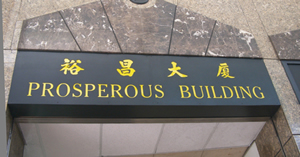
©2011, UrbisMedia-Ltd.
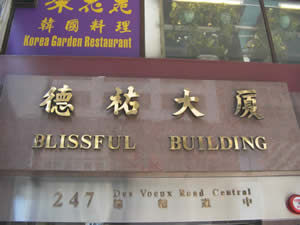
©2011, UrbisMedia-Ltd.
Although some signs clearly display the names of their proprietors they seem almost to have been contrived to simultaneously promote the products of their establishments. The “Hang Fai Curtain” shop in Lyndhurst Terrace is one such example, but my favorite has to be a little shop in Pokfulam: “Hop On Bicycle” says it all.
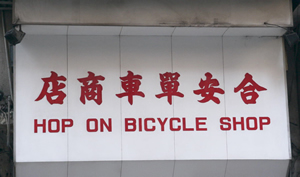
©2011, UrbisMedia-Ltd.
One way of making your establishment seem larger or more imposing is to call your establishment not simply “Shoe Shop,” but “Shoe City,” (although there are two establishments named “Power Shoes,” and “Perfect Shoe”). Hong Kong is a city that contains many cities: In addition to City University and City College, there is “Cyber City,” “Star City. Computer,” “China City,” “Happy City,” “Sim City,” “Game City,” “Win City,” and “Citistore” among those employing this popular appellation. One establishment, “Urban Decay” has a more ironic take on the city sign theme. However, there is something rather titillating and curious about a sign that hangs over a sidewalk in a busy section of Kowloon’s Nathan Road. What could possibly be the doings in an establishment whose sign unabashedly announces:? “City Club, Men and Teen Mix”?
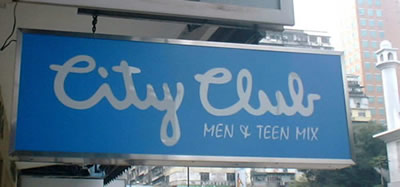
©2011, UrbisMedia-Ltd.
City Club might indeed be a place where some inappropriate mixing occurs, but often it is seems that the inappropriateness is just in not understanding the cross-cultural connotations, especially where matters of sex are concerned. There is, for example, the wonderful “Minute Hotel” I recently discovered. More innocent is an establishment that appears to offer bootyfication. I wonder how one prepares to do that “professionally.” And does this result in what a shop in Admiralty claims to offer?
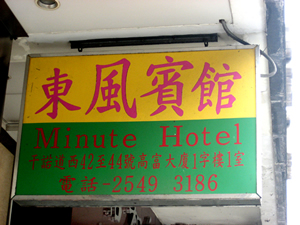
©2011, UrbisMedia-Ltd.
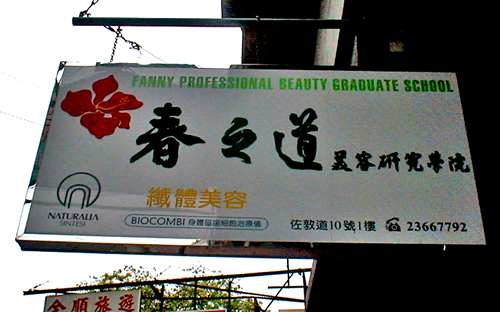
©2011, UrbisMedia-Ltd.

©2011, UrbisMedia-Ltd.
Signage like that can give a guy ideas. But not too worry if things heat up too much, at least if you have access to passion extinguishers such as I spied in a hallway in a hotel in Shanghai. (I’m still wondering what the difference is between level 5 and 6.)

©2011, UrbisMedia-Ltd.
But while Hong Kong residents can be superstitious, a bit overblown, or ambiguous, in representing their buildings and businesses, they are perhaps not much more so than similar establishments elsewhere. But an even more pronounced trait of Hong Kongers is their vaunted obsession with money. The city has nearly as many banks and bank branches as restaurants; Hong Kong people like to be as close to their money as to their food. Although, with regard to the latter, one may wonder about a curious eatery(?) in one of Hong Kong’s streets.

©2011, UrbisMedia-Ltd.
It has been around since 1957, but you still might need the products of a health dispensary, even one as insecure as this one.
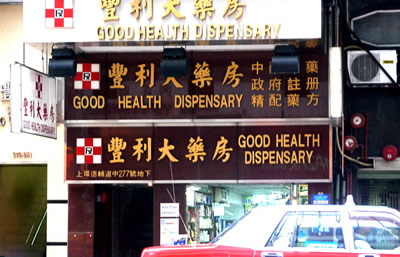
©2011, UrbisMedia-Ltd.
As in cities elsewhere the job competition for women can be intense. By the looks of this sign Hong Kong might have been ahead of the curve in what came to be called “power dressing.”
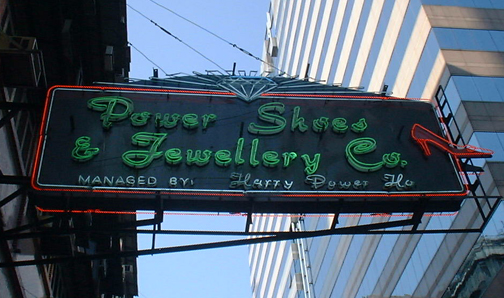
©2011, UrbisMedia-Ltd.
Sometimes signs are employed as such a transparent posture of modernity and sophistication that the entire enterprise backfires. Who would not stifle a snicker, as I did, when riding on the light rail transit system of the New Territories, I sat down and read a poster on the bulkhead in front of me. It was almost all in Chinese, apparently extolling some social program, or a product. But its authors could not resist that Western tendency to phrase a clever epigram to make its message sophisticated as well as memorable. It was at least “memorable” in its proud declaration: “Enhancing the Hearing Impaired into the New Millennium.” One can only hope that the public relations firm that conjured that one does not have its offices in this building.

©2011, UrbisMedia-Ltd.
____________________________________________________________
© 2011, James A. Clapp (UrbisMedia Ltd. Pub. 6.1.2011)
All photos by the author
